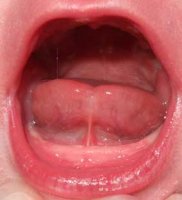Hi ladies.
I know a few awesome Mummies on here who worked through a tongue tie and have successfully gone onto EBF their LOs. I've also noticed quite a few new Mummies coming in and asking about tongue and lip ties.
There is a lot of controversy about how a tongue tie can affect BF'ing and even being in the healthcare industry myself, I have noticed little support for Mums dealing with this very real issue.
So I wanted to start a thread where we can all support each other and questions can be asked in regards to TT - from identification of one, to surgery, BF'ing and bottle feeding.
My personal story is long (you can have a full read in my signature), but in summary I have a LO who had a tongue tie so badly that her tongue was unable to move at all. This means that in utero she had a tongue that was anchored to her mouth. She was unable to move it at all before or after birth.
We had her anterior AND posterior tongue tie cut twice and did weeks of exercise. It took 3-4 weeks to get her onto the breast and almost 10 weeks for me to be comfortable with her EBF'ing and getting enough directly. I still pump 5-7 times a day and BF her about 5-6 times a day. She will have between 2-4 bottles of EBM a day as well. She also had a lip tie which was recently lasered.
Tongue ties are a real and important issue that affect BF'ing mothers far more than most people realise and give credit for.
Don't feel alone. You're not alone. And you CAN succeed in BF'ing!
EDIT
All about Tongue Ties
Tongue-tie is a condition that is caused by a short frenum (string of tissue) that restricts tongue movement. For example, some people have difficulty licking around their lips or raising the tongue tip inside the mouth. This can mean that they have difficulties with eating and speech. The medical name for tongue-tie is ankyloglossia.
Frenula are little strings of tissue found underneath the tongue, inside the cheeks, near the back molars and under the top lip. While an embryo is developing in the womb, these strings guide the growth of some mouth structures. Once we are born, the frenula are largely redundant, although they seem to help in positioning the baby teeth. The frenulum under the tongue is called the lingual frenum.
Symptoms of tongue-tie
> The symptoms of tongue-tie can include:
> Tongue can’t poke out past the lips
> Tongue tip can’t touch the roof of the mouth
> Tongue can’t be moved sideways to the corners of the mouth
> Tongue tip may look flat or square, instead of pointy when extended
> Tongue tip may look notched or heart-shaped
> A baby with tongue-tie may have difficulties breastfeeding or bottle-feeding
> The front teeth in the lower jaw may have a gap between them
Tongue-tie can be hard to diagnose in newborns – it is important to consult with your doctor, A maternal and child health nurse can help or a lactation consultant if you are having trouble breastfeeding. Signs that a baby could be tongue-tied include:
> Mother has sore nipples during and after breastfeeding
> Mother has squashed nipples after breastfeeding
> Mother has a white compression mark on the nipple after breastfeeding
> The baby has difficulty latching on to the nipple
> The baby often loses suction while feeding and sucks air
> The baby’s mouth makes a clicking sound while feeding
> The baby fails to gain weight
Where to get help
> Your doctor or paediatrician
> Maternal and child health nurse
> Lactation consultant
> Speech pathologist
> Your dentist or oral health professional
> Your public oral health service
What treatment is available?
The surgical procedure performed to cut the lingual or labial (tissue in the centre of the upper and lower lip) frenum is called frenectomy. The technique differs according to the age of the person and can include:
Babies less than 12 weeks old – the procedure may be done with local or topical anaesthesia, or occasionally using general anaesthesia. If using local or topical anaesthesia the area is numbed, the baby’s head is held firmly and the frenum is simply snipped (divided) with surgical scissors (or a laser). A number of studies report that breastfeeding is improved immediately after the procedure for some babies. Reports also suggest that tongue movement is normal within three months of the procedure.
Older children and adults – a general or local anaesthetic may be given beforehand. Stitches are needed when the tongue-tie has been surgically divided. It may take a few weeks for the mouth to heal. Self-care suggestions include rinsing with salt water, use of chlorhexidine mouth rinse and taking anti-inflammatory drugs such as paracetemol or ibuprofen. (Do not use aspirin in children under 14 years of age.) Older children and adults may need speech therapy after the surgery.
I know a few awesome Mummies on here who worked through a tongue tie and have successfully gone onto EBF their LOs. I've also noticed quite a few new Mummies coming in and asking about tongue and lip ties.
There is a lot of controversy about how a tongue tie can affect BF'ing and even being in the healthcare industry myself, I have noticed little support for Mums dealing with this very real issue.
So I wanted to start a thread where we can all support each other and questions can be asked in regards to TT - from identification of one, to surgery, BF'ing and bottle feeding.
My personal story is long (you can have a full read in my signature), but in summary I have a LO who had a tongue tie so badly that her tongue was unable to move at all. This means that in utero she had a tongue that was anchored to her mouth. She was unable to move it at all before or after birth.
We had her anterior AND posterior tongue tie cut twice and did weeks of exercise. It took 3-4 weeks to get her onto the breast and almost 10 weeks for me to be comfortable with her EBF'ing and getting enough directly. I still pump 5-7 times a day and BF her about 5-6 times a day. She will have between 2-4 bottles of EBM a day as well. She also had a lip tie which was recently lasered.
Tongue ties are a real and important issue that affect BF'ing mothers far more than most people realise and give credit for.
Don't feel alone. You're not alone. And you CAN succeed in BF'ing!

EDIT
All about Tongue Ties
Tongue-tie is a condition that is caused by a short frenum (string of tissue) that restricts tongue movement. For example, some people have difficulty licking around their lips or raising the tongue tip inside the mouth. This can mean that they have difficulties with eating and speech. The medical name for tongue-tie is ankyloglossia.
Frenula are little strings of tissue found underneath the tongue, inside the cheeks, near the back molars and under the top lip. While an embryo is developing in the womb, these strings guide the growth of some mouth structures. Once we are born, the frenula are largely redundant, although they seem to help in positioning the baby teeth. The frenulum under the tongue is called the lingual frenum.
Symptoms of tongue-tie
> The symptoms of tongue-tie can include:
> Tongue can’t poke out past the lips
> Tongue tip can’t touch the roof of the mouth
> Tongue can’t be moved sideways to the corners of the mouth
> Tongue tip may look flat or square, instead of pointy when extended
> Tongue tip may look notched or heart-shaped
> A baby with tongue-tie may have difficulties breastfeeding or bottle-feeding
> The front teeth in the lower jaw may have a gap between them
Tongue-tie can be hard to diagnose in newborns – it is important to consult with your doctor, A maternal and child health nurse can help or a lactation consultant if you are having trouble breastfeeding. Signs that a baby could be tongue-tied include:
> Mother has sore nipples during and after breastfeeding
> Mother has squashed nipples after breastfeeding
> Mother has a white compression mark on the nipple after breastfeeding
> The baby has difficulty latching on to the nipple
> The baby often loses suction while feeding and sucks air
> The baby’s mouth makes a clicking sound while feeding
> The baby fails to gain weight
Where to get help
> Your doctor or paediatrician
> Maternal and child health nurse
> Lactation consultant
> Speech pathologist
> Your dentist or oral health professional
> Your public oral health service
What treatment is available?
The surgical procedure performed to cut the lingual or labial (tissue in the centre of the upper and lower lip) frenum is called frenectomy. The technique differs according to the age of the person and can include:
Babies less than 12 weeks old – the procedure may be done with local or topical anaesthesia, or occasionally using general anaesthesia. If using local or topical anaesthesia the area is numbed, the baby’s head is held firmly and the frenum is simply snipped (divided) with surgical scissors (or a laser). A number of studies report that breastfeeding is improved immediately after the procedure for some babies. Reports also suggest that tongue movement is normal within three months of the procedure.
Older children and adults – a general or local anaesthetic may be given beforehand. Stitches are needed when the tongue-tie has been surgically divided. It may take a few weeks for the mouth to heal. Self-care suggestions include rinsing with salt water, use of chlorhexidine mouth rinse and taking anti-inflammatory drugs such as paracetemol or ibuprofen. (Do not use aspirin in children under 14 years of age.) Older children and adults may need speech therapy after the surgery.





